Golanth, the Bronze Dragon, is now electrified! Whoee! The electric auxiliary boost drive works pretty much as I had envisioned it. Actually I envisioned the bicycle to be about 10 pounds lighter, but that is another story.
What I have is an Astro 60 Brushless Motor, a 10:1 gear reduction and a 2:1 cogged belt reduction. This is powered by 2 each 9 A-Hr Lead acid batteries. These weigh 12 pounds by themselves. The motor is controlled with an Electronic Speed Controller (ESC). We control that with my Futaba R/C radio control. I am still working on the thumb throttle.
On the web site you will find a couple photos of the power train…and the missing link!
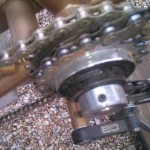
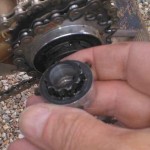
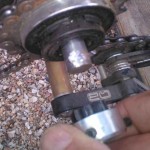
I have been evaluating the drive train and adjusting various components in a series of bench tests and now field tests. On Wednesday we went up and down the same hill four times at various settings and various speeds. We even included a Placebo run. Now a placebo run is where the victims, ah… participants think they are getting the goodies, be it medications or a power boost up the hill. Now how can you set up a trial so that I, the designer, think there is boost when there is none? It’s simple, you just have the key part in the drive train fall off. The “missing link” as it were.
So here is “The Rest of the Story.” On Wednesday we planned several loops around the park. There is a 5/8 mile hill from the lowest point in the park to the highest point on the park. Half of it is 3% grade and the rest is 1% grade. Now Judy and I ride this all the time when we are here. It does wear you down after several laps, however. For the field trial part of this experiment we were to stop at the home base after each loop and measure the voltage on the batteries. You can tell how much energy you have drained out of the batteries that way. The first loop went very slowly and we were using a very low level of boost: The economy mode. We returned to home base and I discovered that splined collar was slipping on the shaft. The set-screws had backed out. We really had no boost at all. I tightened the set screws and the rest of the runs went very well. On the last run we rode up the hill as fast as we usually ride down the same hill.
Today we went on a longer ride. This was to be more a pleasure ride, but with boost on the hill to further shake down the drive train. There is a section of the park, I think of as the “comb” where there are several streets that go up and down the steepest part of the hill. So we were riding the “comb” back and forth and using the booster pack each time we started up one of the hills. We finished up and Judy wanted to return to a lot where the owners had set out some buckets of grapefruit. We rode back to that lot and picked up the grapefruit. One more time we climbed the hill. We must have been getting tired for the hill went slowly and the boost did not seem to help….
Yep: we got home and looked over the drive, and sure enough the splined collar was completely missing. We rode back to the grapefruit stand and sure enough, right there on the pavement was a bit of shiney aluminum . I picked it up and pocketed it. “That was lucky,” I was thinking. It would take a lot of work to replace this special part. At home again I set up my tools to grind a socket under each set screw so they couldn’t work their way off so easily. I checked one pocket and then another… There was no splined collar in any of them. We retraced our route to the grapefruit stand again. We had only gotten a half block before the splined collar fell out of my pocket. There it was on the pavement again.
This time I gave it to Judy to guard. Yes we made it home. Yes I ground out the sockets for the set screws to fit into. Yes I put some low strength thread lock on the set screws this time.
No more placebo hills, I hope!
Here are two photos of the drive train showing the various components.
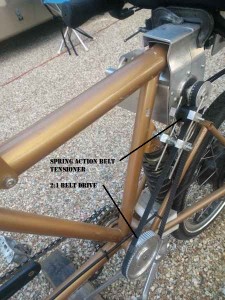
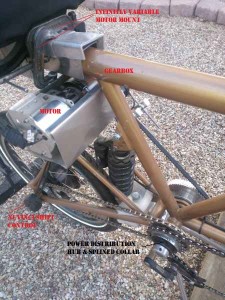
Hmm… I think I’ve seen those “Infinitely Variable Motor Mounts” before. Is that a specialty item you ordered from NASA?